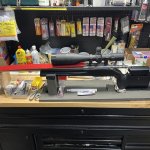The following is a comment out of the Precision rifle Blog from a recognized and respected expert in the field and it concerns the value of sample size in evaluating the precision potential of a particular rifle, ammo and shooter.
No - You don't require this level of testing for hunting purposes This is simply to illustrate the value of a higher sample size and repeatability for determining group performance.
Jayden Quinlan, ballistician at Hornady, says that the very first thing he does in his process of setting up a new rifle is “getting a really good handle on what the system is capable of. I’m glad we talked about this part because I believe it often gets overlooked. One part of that is cost because there is a cost associated every time we pull the trigger, both in barrel life and cost of components. The second part is ego: We don’t want to know how bad our system really is. I have a 1/2 MOA rifle every time I do my part – that cracks me up every time I hear it. So here is my typical response to someone who says “I have a 1/4 MOA or 1/2 MOA rifle.” My first question is, “Over how many shots? 2 or 5 or 10 or 30?” Because that’s important to know. If we’re talking about some kind of dispersion we need to know the sample to quantify if it is good or not. Because a 1/4 MOA group that is 2 shots doesn’t really tell me a whole lot, but a 1/4 MOA group that is 10 shots tells me a whole lot. So how many shots? That’s the first question, and generally, it is a super small sample size and it was done once, and the next group was 1 inch.
The argument is if you truly have a 1/2 MOA rifle at 1000 yards, and it’s a shoulder-fired, hunting-type, lightweight field rifle and it shoots 1/2 MOA at 1000. If it does, then take it to the heavy Benchrest Nationals because you’re probably going to win. You know?! Look at the average group size of those rifles. I’m sorry, I don’t believe you.
Putting ego aside, what is it really capable of? So I shoot no less than 10 shot groups when I’m testing my dispersion. Dispersion is pretty much linear, and it goes in non-linear when you add in velocity and drag and stuff like that. So aiming error and dispersion are kind of linear. So I shoot them at 100 yards, and no less than 10 shots. And I don’t have a big giant ego fit if it is 1 MOA, and I don’t have a big giant ego if it is 3/4 MOA.
We’ve done enough large sample size testing in 50 shot groups to understand that you’re chasing your tail sometimes when you’re trying to squeeze that last little bit out of it, and when you think you have it your sample size isn’t large enough for that to actually be valid. Because when I go to a match, how many shots am I shooting? 200 rounds? 250? So how representative is my sampling of 10 to my capability for 200 or 250? Not as good as you think.
So I shoot no less than 10 for my baseline. Let’s say it is 1 MOA. Okay, then 1 MOA is my baseline. Then I move on to testing my muzzle velocity …”
Well said, Jayden! Lots of wisdom there.
Again this level of testing is overkill for the average hunter and certainly not required for hunting.. I've included this just to illustrate a point about sample size and repeatability. More data points is better in determining your rifle/ammo capability subject of course to amount of your money/resources required to test.
And for those who only read what is required to put words out of context - this degree of testing is not necessary for hunting











































































